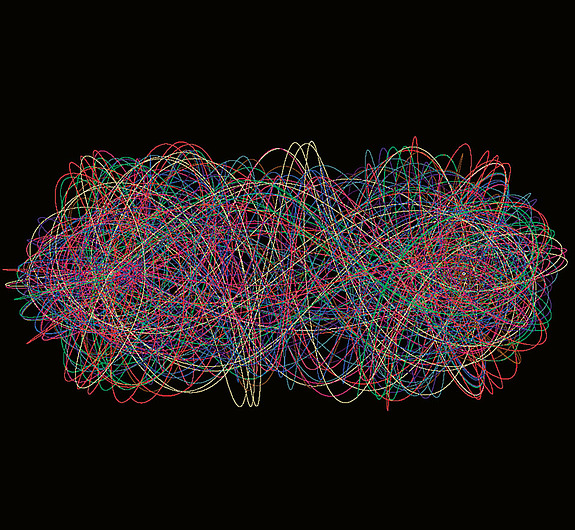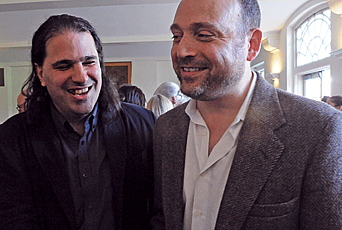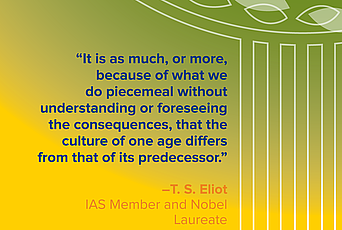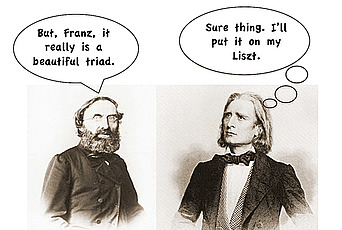The Symplectic Piece

Helmut Hofer, Professor in the School of Mathematics, writes:
Last September, the School of Mathematics launched its year-long program with my Member seminar talk “First Steps in Symplectic Dynamics.” About two years earlier, it had become clear that certain important problems in dynamical systems could be solved with ideas coming from a different field, the field of symplectic geometry. The goal was then to bring researchers from the fields of dynamical systems and symplectic geometry together in a program aimed at the development of a common core and ideally leading to a new field—symplectic dynamics.
Not long before, in my 2010 inaugural public lecture at IAS, “From Celestial Mechanics to a Geometry Based on the Concept of Area,” I had described the historical background and some of the interesting mathematical problems belonging to this anticipated field of symplectic dynamics. The lecture began with a computer program showing chaos in the restricted three-body problem. This problem describes the movement of a satellite under the gravity of two big bodies, say the earth and the moon, in a rotating coordinates system in which the earth and the moon stay at fixed positions. The chaos in the system is illustrated by putting about ten satellites initially at almost the same position with almost the same velocity.
I can’t understand why people are frightened of new ideas. I’m frightened of the old ones.—John Cage
When the system starts evolving, the program shows colorful trackings of the paths of the satellites as they evolve from a simple single orbit to a complex multicolored tangle of orbits, once the orbits of the different satellites start separating.
Among those in the audience at my 2010 IAS lecture was composer Derek Bermel, then the newly appointed Artist-in-Residence. As I got to know Derek, I realized that he was interested in mathematics. So when I began planning my upcoming program in symplectic dynamics, I thought it would be quite something if our resident composer wrote what we would come to refer to as “The Symplectic Piece”—a musical composition inspired by symplectic geometry.
Symplectic geometry is a large field in mathematics, with connections to physics, low-dimensional topology, and geometry, as well as the theory of dynamical systems. The modern fields of symplectic geometry and dynamical systems originate in Henri Poincaré’s work on celestial mechanics. The term “symplectic” was introduced in 1939 by Hermann Weyl, a Faculty member at IAS, as a verbum pro verbo for “complex” in his important work on the classical groups—the so-called line complex group became the symplectic group.
Derek and I had several conversations during lunches about the potential for “The Symplectic Piece.” And he continued to attend occasional lectures on the subject, searching for a way to map symplectic geometry onto a musical score. But despite many entertaining discussions, the crucial inspirational idea was missing. With the start of the symplectic dynamics program last fall, “The Symplectic Piece” was still just floating around in the ether.
Then one day Derek mentioned that he had been invited by the Look and Listen Festival in New York to compose a commissioned work to mark the one-hundredth birthday of the avant-garde composer John Cage, said to be one of the most influential American composers of the twentieth century. However, besides having too many commitments already, Derek felt that a Cage composition might be beyond his comfort zone as a composer, so he declined the offer.
But as Cage once said: “Ideas are one thing and what happens is another.”
Or, to put it another way, I just had to talk Derek into it.
Since good preparation is everything, I conducted some research via my subscription to the music service Rhapsody, searching for John Cage and selecting “Play All Top Tracks.” Initially, it seemed my one-month-old headset was already broken. Further investigation revealed that the most popular track—4’33’’—was a three-movement composition for any instrument where the score explicitly instructs performers not to play for the duration of four minutes and 33 seconds, the listener’s experience consisting merely of ambient sounds in the surrounding environment. Composed in 1952, this ostensibly silent work caused an uproar. Around this time in his career, Cage began to incorporate chance elements—chance operations and chance techniques—into his compositions.
Here was the perfect inspiration for symplectic music. Chance, chaos, stability, and comfort zone: these were the connections. Symplectic dynamics studies dynamical systems, which in general show a whole spectrum of behaviors from stable motions to deterministic chaos—from the “comfort” of stability, the system evolves to be governed completely by chance.
Certain simple-looking systems exhibit interesting complex dynamics. The aforementioned movement of a satellite in the gravitational field of the earth and the moon is one of them. The satellite can exhibit stability if parked with the right momentum at one of the triangular Lagrange points. On the other hand, the structure of the possible orbits that the satellite can trace out, if given the appropriate initial data, allows for many random patterns of transitions between earth and moon.
One day at lunch, Derek pressed me on the question of deterministic chaos. He joked that it could be an ideal starting point for a Cage-inspired composition. I pounced on the opportunity and suggested that he now had no excuse not to accept the commission. Over several more lunches with Derek, he became convinced. We continued to discuss the logistics of how to map some of the formal aspects of the three-body problem onto a live musical performance. Members Peter Albers and Alvaro Pelayo provided input as did local mathematician and painter Ed Belbruno, whose ideas for using dynamical systems and chaos theory to obtain new low-energy pathways to the moon resulted in the rescue of the Japanese spacecraft Hiten in 1991.
“The Symplectic Piece” would be a musical representation of the “gravitational choreography.” A body enters another body’s neighborhood, orbits around it and then leaves, perhaps visiting another body, returning, and so on. Working from this idea, Derek set to work developing a musical algorithm for three or more players.
But how exactly would Derek do this? This was the big question . . .
Derek Bermel, Artist-in-Residence, writes:
Once I decided to take the bait and write “The Symplectic Piece,” I tried to narrow down my options. My first questions: How could I create an auditory manifestation of something as abstract and complicated as symplectic dynamics? What kind of piece would this be? Would it carry hallmarks of a particular musical style? What instruments would play? What would make sense for a tribute to John Cage? I was daunted by many issues, not the least of which was the specter of serial composition, which had produced a good deal of drab music.
One of my problems with serialism is that, though it aspires to be “mathematical” in its ordering, its underpinnings nonetheless seem to involve little more than basic arithmetic (pitch sets, inversions, retrogrades, retrograde-inversions, etc.) rather than higher-order concepts. I was searching for an open approach that was less chained to formal details and more genuinely inspired by symplectic dynamics’ principles. Other (in my opinion) more successful models existed for music based on mathematical processes—such as the stochastic music of Iannis Xenakis or the spectral music of Gérard Grisey and Tristan Murail. But these were more closely linked to probability theory and Fourier analysis, respectively, and seemed therefore only tangentially related to symplectic systems.
Then there was the problem of abstraction. Since music is composed of vibrating atoms of air, I needed an analogy that was dynamic. Helmut suggested the title Orbit Design to me. It refers to the design of a route for a scientific space mission, using the varying gravitational fields of the planets to find pathways that are both scientifically interesting and energy efficient. Orbit design seemed like a good model because it deals with the physical relationships of celestial bodies, where Newton’s gravitational law is expressed through their chaotic dynamical interaction.
Of course, besides the mathematical imperatives mentioned above, John Cage was looming. I decided to embrace his ghostly presence not only in spirit but also in form. Cage wrote many compositions for open instrumentation (including 4’33”). I was drawn to this concept for “The Symplectic Piece,” since it would inject an element of controlled unpredictability—or “deterministic chaos”—into the performance. While an undergrad at Yale, I played several of Cage’s Variations compositions (1958–67), in which the performers are given instructions for producing sound, but no actual notation of rhythm, pitch, or anything else. Though their actual manifestations could be compared to other 1960s “happenings,” the formal structure of the Variations tends to be more rigorous and specific. Something similar seemed suited to my needs. If I tweaked the approach, I could produce a kind of algorithm—or “game”—that would allow musicians to choose their own musical material, map out a unique composition using this material, and interact with the other performers.
I also found inspiration in John Zorn’s Cobra and Butch Morris’s early Conductions, works from the 1980s that present a series of ground rules from which a composition takes shape. I eschewed the use of Cage’s “chance” in favor of “risk,” since (as Morris writes) “risk insinuates a certain kind of challenge; chance doesn’t necessarily do that.”
I titled the work Orbit Design, for three or more performers. A set of guidelines assists the performers to structure a path of decision-making as events unfold. The piece taxes their skills and perception via material chosen by them. I therefore leave the decisions—the “risk”—in the hands of the performers themselves. As Cage wrote, “My work became an exploration of non-intention . . . making my responsibility that of asking questions instead of making choices.”
In Orbit Design, each performer establishes a unique vocabulary by making a selection from various musical parameters. Typical parameters might include: pitch (frequency—organized into modes, microtones, chords, and scales, which suggest the notion of octave equivalence, or other sets); pulse (elemental rhythmic units); note length (which might include articulation); tempo (speed); volume (loudness); color (timbre, including specific effects and strength of timbral modulation); and spatial placement/motion (physical location of performers).
Combining these parameters generates compound musical events comprising series, sequences, or patterns. These compound parameters include: density (pulse + tempo); duration (pitch + pulse layer + tempo); melody (pitch + pulse); and contour (register + tempo).
A third, more complex level of relationship that occurs between performers—the overall language of the piece—includes: rhythm (layers of pulse); orchestration (layers of timbre); harmony/cadence (layers of pitch); and counterpoint (layers of pitch + pulse).
My actual “composition” merely supplies instructions as a sort of musical grammar to the performers. Each performer must select their own narrow range of values that apply to their own musical parameters. For example, a flute player might choose initial pitch (and register) values by selecting the set of chromatic half steps between c3 and f#3 inclusive; for initial pulse and tempo values, the flutist might select half notes (semiminims) and quarter notes (crotchets) at sixty beats per minute. The flutist continues to select value ranges for volume, timbre, spatial placement in the room, and any other data relevant to the performers’ vocabulary, making sure it is clearly notated.
The performers then decide which parameters will remain static (constant) and which ones will expand. For dynamic parameters, the performers indicate how (in which direction) they will expand and set range limits for this expansion. For example, the flutist might set the range of pulse values so that it expands to incorporate whole notes (as well as the initial quarter and half notes). The performer might allow the pitch range to expand to all chromatic notes between c3 and c4 inclusive, and could also decide that the volume will remain constant, at mp. In this case, volume would be considered an inert parameter.
Finally, the performers decide in which order the parameters will expand. Only one parameter at a time can be dynamic, so that the players can concentrate on tracking its expansion. The performer then remains at the outer limit of each completed parameter while expanding the following one, and so on, until the end of the piece. After all the parameters, their ranges, and the order of expansion have been determined, the performers assemble to try them out together. After a first playing/hearing, each performer makes adjustments to the scope of their own material, in order to complement their collaborators’ particular design.
The most improvisatory, or “chaotic,” element of the performance is orbiting. Orbiting requires a relationship with the other players, which involves hearing and interacting with what the others play from a vantage point that changes with time. As the performers develop and become comfortable with their own chosen material, it becomes easier to move in and out of each other’s orbits.
Over the course of our discussions, Helmut pointed out that the notion of orbiting around something is not exactly defined in physics. Nonetheless, if the bodies’ masses were about the same size, they could be said to orbit each other. He also drew a chart, which showed that if three celestial bodies A, B, C exist, they could be located either close to each other (ABC), far away from each other (A—B—C), or in various other configurations: (AB)—C, (BC)—A, (AC)—B. Also, if B and C were of comparable size and A was much bigger, then the system (BC) could be said to orbit around A, and so forth. I felt that these maxims could apply directly to performers in Orbit Design.
Helmut had also noted that solutions exist to the three-body problem in which the bodies move from one configuration to another in random order. For example:
(ABC) >> (AB)—C >> (ABC) >> A—B—C >> (AC)—B >> (AB)—C >>, etc.
Such a “sentence” could map one realization of a performance of Orbit Design. Of course, there are many, many others. Indeed, as a consequence of the “open” nature of the score (which, as noted, consists only of written instructions), each performance necessarily ends up being distinct.
Recognizing the unique element, the festival directors scheduled the premiere on three successive nights with three completely different ensembles. On the first night, Orbit Design was performed by a percussion sextet featuring So Percussion Quartet, Doug Perkins, and Bobby Previte; the second night it was played by the trio Forbidden Flute; and the third night it was realized by the string quartet Brooklyn Rider. The three incarnations differed vastly; each had its own profile and dynamic shape. The percussion was sprawling yet serene, the flutes sporadic and sinuous, the string quartet alternately comic and blissful. The players performed with formidable concentration, and afterward they expressed deep satisfaction with the opportunity to build their own compositions from “scratch.”
As the date of the premiere grew near, I decided that there was no reason to restrict Orbit Design to musical realizations, as the instructions could apply equally well to dancers, actors, jugglers, or any kind of performer. My friend, choreographer Abigail Levine, who had helped me hone some of the formal concepts, attended the performances and decided to choreograph the work for an upcoming project with Movement Research at the Judson Church in New York City. She paired it with a dance for three performers, titled Distance Measures, and I participated as one of the musicians, alongside Forbidden Flute. Thus the gravitational “choreography” to which Helmut alluded finally had a chance to manifest itself in real time and evolve into another dimension.


